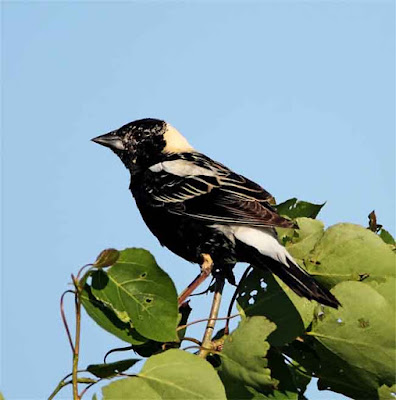The Tricolored Blackbird is an endangered bird of coastal California. Although it is not particularly colorful, it is distinguished from the more common Red-winged Blackbird by the white wing stripe. This bird also has a red wing patch above the white, but mostly it is hidden except when displaying. The best place to see this bird in the central California coast is the famous Moonglow Dairy north of Monterey, where this photo was taken.
 |
| Tricolored Blackbird - male |
 |
| Red-winged Blackbird - male |
The Yellow-headed Blackbird breeds across western and central USA and western Canada. It can be found in winter in the Houston area in huge mixed blackbird flocks.
The male as a yellow head and breast with a white wing patch.
 |
| Yellow-headed Blackbird - male |
The Red-breasted Blackbird is actually the same genus as our meadowlarks. It is a resident from Costa Rica to central South America. The bright red underparts and black back are stunning.
 |
| Red-breasted Blackbird |
 |
| Bobolink - male |
Orioles are generally orange and black or yellow and black. One exception is the common Orchard Oriole where the male is chocolate brown and black. It nests in the eastern and central USA and can be readily seen in spring migration. It also breeds in the Houston area.
 |
| Orchard Oriole - male |
There are 2 yellow and black orioles in the USA. The 9.5" Audubon's Oriole can be found in south Texas.
 |
| Audubon's Oriole |
The Bullock's Oriole is the western counterpart of the Baltimore Oriole. For a time in the 80's and 90's they were lumped together as Northern Oriole. It has a mostly orange head and extensive white on the wings.
 |
| Bullock's Oriole |
Our largest oriole is the 10" Altamira Oriole. It is another bird of the Rio Grande Valley in Texas.
 |
| Altamira Oriole |
The Black-vented Oriole is a resident of Mexico to Nicaragua. Periodically one will show up in south Texas. This was a lifer for me and it was photographed at Bentsen-Rio Grande State park in January 2012.
 |
| Black-vented Oriole |
 |
| Spot-breasted Oriole |
The 11" Yellow-rumped Cacique is a resident from Panama to eastern South America. It has a pale yellow bill, blue eye and bright yellow rump.
 |
| Yellow-rumped Cacique |
David McDonald
dkmmdpa@gmail.com
photos copyright 2006 - 2015 David McDonald
To have these trip reports sent to your email, please email me at the above address and ask to subscribe.
No comments:
Post a Comment